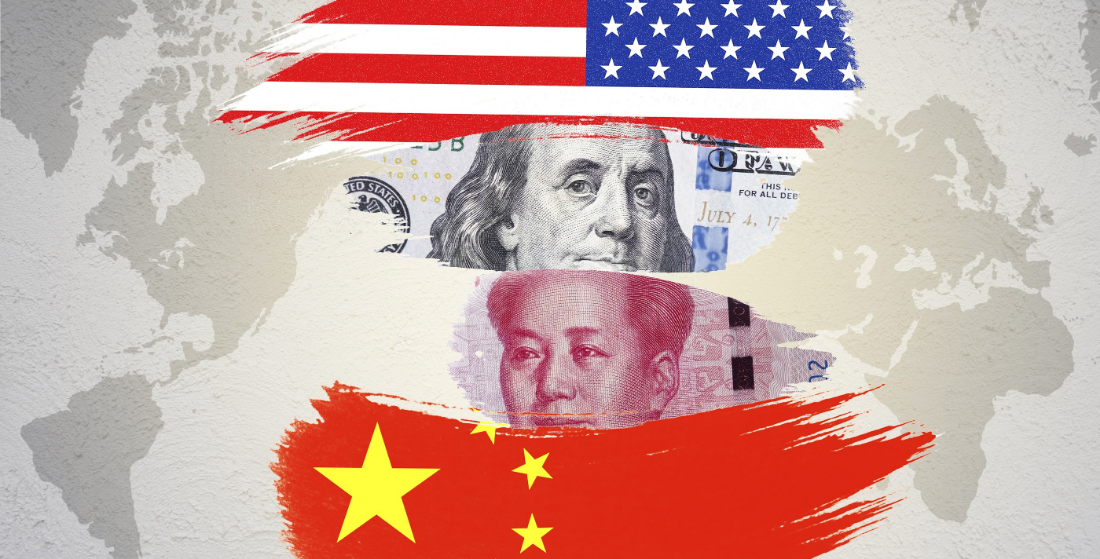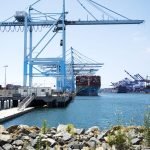
Decoding the US-China Trade War: Economics, Politics, and the Future of Global Relations.
Posted in :
The US-China trade war exposes a complex battle for global dominance, impacting economies, supply chains, technology, and political alliances worldwide, with far-reaching consequences for the future of international relations.
The US-China trade war, from underlying economic motivations to the political ramifications and future outlook.
In a world increasingly shaped by global trade tensions, the US-China trade war stands as a striking example of economic and political complexity. A recent conversation with economist Richard Wolf sheds light on the multifaceted nature of this conflict. From technology tariffs to concerns over national debt, the implications of this trade war extend far beyond mere numbers and policies—it’s a battle for global influence.
Understanding the Broader Implications of the US-China Trade War
The US-China trade war has reshaped the economic landscape in ways that are profound and far-reaching. It’s not just about tariffs; it’s a complex web of geopolitical and economic factors. Richard Wolff, a noted economist, emphasizes that “the trade war is not just about economics; it’s about geopolitics and future influence.” This statement encapsulates the essence of the conflict. But what does this mean for the global economy?
An Overview of the Economic Landscape
To understand the implications of the trade war, one must first grasp the sheer scale of the economic landscape it influences. Over 35 trillion dollars in trade has been affected globally. This staggering figure highlights the interconnectedness of economies today. When one country imposes tariffs, it sends ripples through global markets.
For instance, the United States has imposed billions in tariffs on Chinese goods. This has led to increased costs for American consumers and businesses. Many companies are caught in a bind, facing higher prices for imported materials. This situation raises a critical question: how sustainable is this approach in the long run?
Impact on Global Supply Chains and Local Economies
The trade war has disrupted global supply chains significantly. Companies that relied on smooth operations across borders now face uncertainty. This uncertainty affects local economies as well. When businesses struggle, local employment rates can take a hit. Workers may find themselves facing layoffs or reduced hours.
- Increased costs for consumers
- Job losses in affected industries
- Shifts in manufacturing locations
Moreover, the unpredictability of tariffs creates a challenging environment for investment. Companies hesitate to commit to new projects when they are unsure about future costs. This hesitation can stifle innovation and growth. It’s a vicious cycle that can lead to stagnation.
Technological Advancements as a Hotspot in the Conflict
Another critical aspect of the US-China trade war is the competition in technology. Both nations are vying for dominance in sectors like artificial intelligence, telecommunications, and biotechnology. This technological race is as significant as the tariff disputes. Wolff points out that the trade conflict encompasses a broader spectrum of economic and geopolitical struggles.
China’s investments in technology and education are noteworthy. As the US grapples with its own educational challenges, such as rising tuition costs and declining college enrollment, China continues to advance. This raises an alarming question: will the US fall behind in the global technological race?
As the trade war unfolds, the implications for technological innovation are profound. Companies in both countries are forced to rethink their strategies. They must navigate a landscape where collaboration may be stifled by political tensions. This could lead to a fragmented technological ecosystem, where advancements are limited by national borders.
The Broader Economic Implications
The economic implications of the trade war extend beyond immediate tariffs and trade barriers. Wolff highlights that the US has accumulated debts exceeding $35 trillion. This staggering figure raises concerns about the sustainability of US economic policies. Countries like Japan and China, which hold significant portions of this debt, are beginning to reconsider their lending strategies. This shift could have long-term consequences for US foreign relations.
Furthermore, the trade war has marked a transition from globalization towards a more nationalistic economic stance. This shift has implications for international relations and alliances. The US, traditionally a proponent of free trade, now finds itself in a position where it must reassess its global role.
In conclusion, the US-China trade war is a multifaceted conflict with far-reaching implications. It affects not only the economies of the two nations involved but also the global economic landscape. As Richard Wolff aptly puts it, the trade war is about more than just economics; it’s about the future of global influence. The stakes are high, and the outcomes remain uncertain.
The Political Landscape Behind the Trade War
The trade war between the United States and China is not just about tariffs. It’s a complex web of political maneuvering, public sentiment, and economic strategy. Understanding this landscape requires a closer look at how domestic politics influence trade decisions, the role of the Democratic opposition, and the impact of public opinion.
Domestic Politics and Trump’s Trade Decisions
Domestic politics play a crucial role in shaping President Trump’s trade policies. His administration’s decisions often reflect a need to cater to his political base. For instance, the push for tariffs on Chinese goods can be seen as a response to the frustrations of American workers who feel left behind by globalization. These tariffs are not merely economic tools; they are political statements.
- Political necessity: Trump’s trade policies are often described as a reflection of political necessity rather than economic foresight. This means that decisions are made with an eye on upcoming elections and voter sentiment.
- Power dynamics: The weakness of the Democratic Party, especially after their loss in the 2016 elections, has allowed Trump to pursue aggressive trade policies without significant opposition.
As economist Richard Wolff points out, the trade war is primarily a U.S. initiative. It’s not just about tariffs; it’s about asserting dominance in a changing global landscape. The U.S. has long been the dominant economic force, but that status is being challenged.
The Role of the Democratic Opposition
The Democratic Party has a significant role in shaping trade policy, even when they are not in power. Their opposition to Trump’s tariffs is often framed around the idea of protecting American jobs and promoting fair trade. However, their critiques can sometimes lack a coherent alternative strategy.
- Fractured narratives: The Democratic Party struggles to present a unified front on trade. This fragmentation can lead to mixed messages for voters.
- Voter expectations: Both parties navigate complex voter expectations. Democrats must balance the interests of labor unions with the demands of a global economy.
As the political landscape shifts, the Democratic Party faces pressure to develop a more robust trade policy that resonates with their base. This is crucial, especially as public sentiment fluctuates regarding tariffs and trade agreements.
Public Sentiment and Political Strategies
Public opinion is a powerful force in shaping trade policy. Polls indicate fluctuating support for tariffs, which can shift dramatically based on economic conditions. When the economy is strong, support for tariffs may wane. Conversely, during economic downturns, there may be a resurgence in favor of protectionist measures.
- Economic challenges: As economic challenges persist, political narratives change. Politicians must adapt their strategies to align with public sentiment.
- Election cycles: The timing of elections can significantly impact trade negotiations. Politicians often use trade policy as a tool to rally support during campaigns.
Wolff emphasizes that the uncertainty surrounding U.S. tariffs creates instability in the marketplace. Companies hesitate to invest when they cannot predict future trade policies. This unpredictability can have far-reaching consequences for both American investors and multinational corporations.
In summary, the political landscape behind the trade war is multifaceted. Domestic politics, the role of the Democratic opposition, and public sentiment all intertwine to shape trade policy. As the U.S. navigates these complexities, the implications for both the economy and international relations remain significant.
“What we see in trade policy is a reflection of political necessity rather than economic foresight.”
The internal political dynamics within the U.S. play a crucial role in shaping responses to the trade conflict. This often complicates negotiations and strategies, making it essential to understand the broader context of these decisions.
The Future of Global Trade Relations: What Lies Ahead?
The landscape of global trade is shifting. As nations grapple with the aftermath of recent conflicts, the future of trade relations remains uncertain. Predictions about the trade landscape post-war are varied, yet they all point to significant changes. Economists and analysts are closely watching how these dynamics will unfold, especially in regions like Europe and Asia.
Predictions on the Trade Landscape Post-War
In the wake of the trade war, many experts believe that the global trade environment will undergo a transformation. The conflict has highlighted vulnerabilities in supply chains and trade dependencies. Countries are now reconsidering their partnerships. This could lead to a more fragmented trade landscape, where nations prioritize local production over global supply chains.
- Emerging Economies: Countries like India and Brazil may rise in prominence as they seek to fill gaps left by traditional powers.
- New Alliances: Nations may form new alliances based on shared interests rather than historical ties.
- Technological Shifts: The digital economy will play a crucial role in shaping future trade relations.
As Richard Wolff notes, “Going forward, we must consider how trade partnerships may evolve in a post-COVID world.” This statement encapsulates the need for adaptability in international trade. The pandemic has already forced many countries to rethink their economic strategies.
Regional Implications for Europe and Asia
Europe and Asia are at the forefront of these changes. The European Union has been working to strengthen its internal market while also seeking new trade agreements. Meanwhile, Asia, particularly China, is expanding its influence through initiatives like the Belt and Road Initiative. This could lead to a rebalancing of power in global trade.
For Europe, the implications are profound. The EU must navigate its relationships with both the U.S. and China. As the U.S. adopts a more nationalistic approach, European nations may find themselves caught in the middle. They will need to balance their economic interests with political pressures.
In Asia, the rise of China as a dominant economic force cannot be ignored. Countries in the region are increasingly looking to China for investment and support. This shift could lead to a more unified Asian economic bloc, which may challenge Western dominance in global trade.
Potential Paths for Cooperation or Continued Conflict
The future of global trade relations could take two distinct paths: cooperation or continued conflict. On one hand, nations may recognize the benefits of collaboration. Shared challenges, such as climate change and economic recovery, could foster partnerships. Countries might come together to create new trade agreements that prioritize sustainability and mutual benefit.
On the other hand, the potential for conflict remains high. Nationalistic policies and protectionist measures could lead to further tensions. The unpredictability of U.S. trade policies, as highlighted by Wolff, creates an environment of uncertainty. Companies are hesitant to invest when they cannot predict future tariffs or trade barriers.
Moreover, the demographic and educational crises in the U.S. could exacerbate these tensions. As Wolff points out, the decline in skilled labor may hinder America’s ability to compete globally. This could lead to a further decline in U.S. influence, pushing other nations to seek alternative partnerships.
The future of global trade relations is fraught with uncertainty. As nations navigate the complexities of post-war dynamics, the potential for both cooperation and conflict looms large. Emerging economies may rise, while traditional powers reassess their roles. The implications for Europe and Asia are significant, as they adapt to a changing landscape. Ultimately, the choices made today will shape the economic realities of tomorrow. The world is watching closely, and the stakes have never been higher.
TL;DR: The US-China trade war encapsulates a struggle of economic dominance, revealing deep political implications and signaling a changing global dynamic.
GlobalEconomics, EconomicImplications, TradeTariffs, InternationalRelations, TrumpAdministrationPolicies, US-ChinaTradeWar
#InternationalRelations, #US-ChinaTradeWar, #TradeTariffs, #EconomicImplications, #TrumpAdministrationPolicies, #GlobalEconomics,#USChinaTradeWar, #GlobalEconomy, #TradePolicy, #Geopolitics, #Tariffs, #SupplyChains, #InternationalRelations, #EconomicImpact

